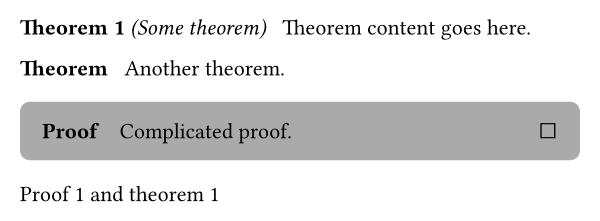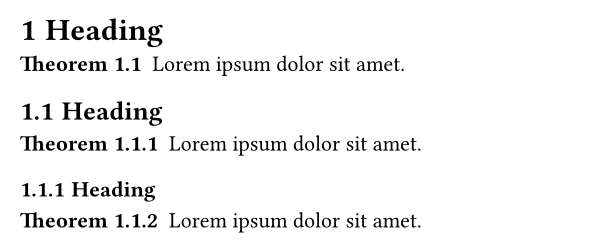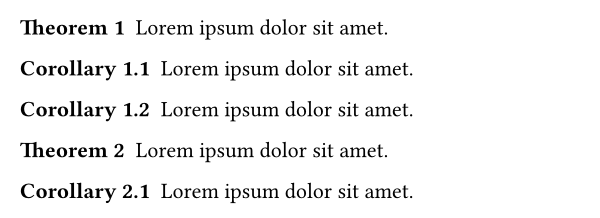Lemmify is a library for typesetting mathematical theorems in typst. It aims to be easy to use while trying to be as flexible and idiomatic as possible. This means that the interface might change with updates to typst (for example if user-defined element functions are introduced). But no functionality should be lost.
If you are encountering any bugs, have questions or are missing features, feel free to open an issue on GitHub.
- Import lemmify:
#import "@preview/lemmify:0.2.0": default-theorems, select-kind
- Generate some common theorem kinds with pre-defined style:
#let (
theorem, lemma, corollary,
remark, proposition, example,
proof, theorem-rules
) = default-theorems(lang: "en")- Apply the generated style:
#show: theorem-rules- Customize the theorems using show rules. For example, to add a block around proofs:
#show select-kind(proof): block.with(
breakable: true,
width: 100%,
fill: gray,
inset: 1em,
radius: 5pt
)- Create theorems, lemmas, and proofs:
#theorem(name: "Some theorem")[
Theorem content goes here.
]<thm>
#theorem(numbering: none)[
Another theorem.
]
#proof(link-to: <thm>)[
Complicated proof.
]<proof>
@proof and @thm[theorem]The result should now look something like this:
By default theorems are reset on every heading. This can be changed with the
max-reset-level
parameter of
default-theorems(). This also
changes which heading levels will be used in the numbering. To not reset them
at all
max-reset-level
can be set to 0.
#import "@preview/lemmify:0.2.0": default-theorems
#let (
theorem, theorem-rules
) = default-theorems(max-reset-level: 2)
#show: theorem-rules
#set heading(numbering: "1.1")
= Heading
#theorem(lorem(5))
== Heading
#theorem(lorem(5))
=== Heading
#theorem(lorem(5))Each theorem belongs to a group and every group shares one counter. The theorems created
by
default-theorems()
all belong to the same group, except for proofs.
You can create seperate groups by passing a group parameter to
default-theorems().
The next example shows how to create seperately numbered examples.
#import "@preview/lemmify:0.2.0": default-theorems
#let (theorem, theorem-rules) = default-theorems()
#show: theorem-rules
#let (
example, theorem-rules
) = default-theorems(group: "example-group")
#show: theorem-rules
#theorem(lorem(5))
#example(lorem(5))
#example(lorem(5))
#theorem(lorem(5))The link-to parameter can be used to link theorems to other content. By default
theorems are linked to the last heading and proofs are linked to the last theorem.
This example shows how corallaries can be linked to the last theorem.
Note that it's fine to only apply the
theorem-rules
once here since both theorem-kinds belong to the same group.
#import "@preview/lemmify:0.2.0": default-theorems, select-kind, reset-counter
#let (theorem, theorem-rules) = default-theorems()
#let (corollary,) = default-theorems(
group: "corollary-group",
link-to: select-kind(theorem)
)
#show: theorem-rules
#show select-kind(theorem): it => {it; reset-counter(corollary)}
#theorem(lorem(5))
#corollary(lorem(5))
#corollary(lorem(5))
#theorem(lorem(5))
#corollary(lorem(5))The best and easiest way to change the look of theorems is to use show-rules. The next example shows another way how the appearance of theorems can be changed.
#import "@preview/lemmify:0.2.0": default-theorems, style-simple
#let (
theorem, proof, theorem-rules
) = default-theorems(
lang: "en",
style: style-simple.with(seperator: ". "),
proof-style: style-simple.with(kind-name-style: emph, seperator: ". ")
)
#show: theorem-rules
#theorem(lorem(5))
#proof(lorem(5))Doing the same thing to remarks is a bit more complicated since the style parameter applies to both theorems and remarks.
#import "@preview/lemmify:0.2.0": default-theorems, style-simple
#let (
theorem, theorem-rules
) = default-theorems(
lang: "en",
style: style-simple.with(seperator: ". ")
)
#let (remark,) = default-theorems(
style: style-simple.with(kind-name-style: emph, seperator: ". "),
numbering: none
)
#show: theorem-rules
#theorem(lorem(5))
#remark(lorem(5))If the pre-defined styles are not customizable enough you can also provide your own style.
#import "@preview/lemmify:0.2.0": default-theorems, get-theorem-parameters
#let custom-style(thm) = {
let params = get-theorem-parameters(thm)
let number = (params.numbering)(thm, false)
block(
inset: .5em,
fill: gray,
{
params.kind-name + " "
number
if params.name != none { ": " + params.name }
}
)
v(0pt, weak: true)
block(
width: 100%,
inset: 1em,
stroke: gray + 1pt,
params.body
)
}
#let (
theorem, theorem-rules
) = default-theorems(lang: "en", style: custom-style)
#show: theorem-rules
#theorem(name: "Some theorem")[
#lorem(40)
]There is one other way to create
theorem-functions:
the
theorem-kind()
function. It is used to create
the theorem-functions returned by
default-theorems()
so it behaves almost the same. The only difference is that there is no
max-reset-level
parameter and that no
theorem-rules
are returned.
A default rule which does not reset any theorem counters can be imported.
#import "@preview/lemmify:0.2.0": theorem-kind, theorem-rules
#let note = theorem-kind("Note")
#show: theorem-rules
#note(lorem(5))For a full documentation of all functions check the pdf-version of this readme.







